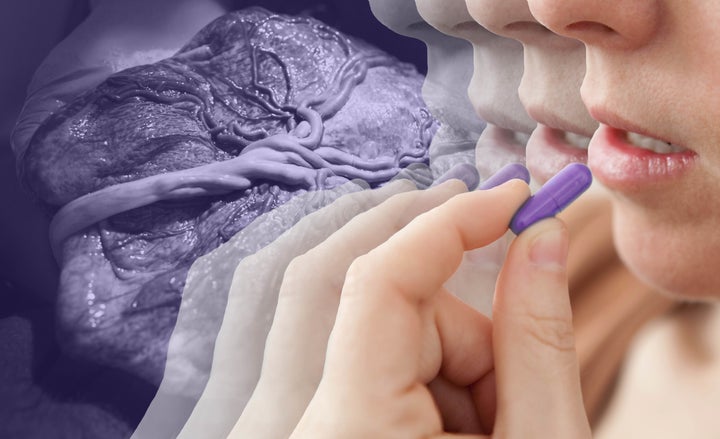

Earlier this summer, the Centers for Disease Control ― the federal agency tasked with tackling the world’s biggest health threats, like Ebola and heart disease ― focused its sights on a decidedly more niche topic: placenta pills.
The “Notes From The Field” report centered around an infant in Portland, Ore. who had been hospitalized twice after falling ill with late-onset Group B streptococcus, a bacteria that is generally harmless in adults, but can be extremely dangerous for newborns. The baby’s doctors determined that the likely source of the recurring infection were contaminated placenta pills the mother had been taking since giving birth. Placenta capsules, the CDC field report cautioned, should be avoided.
That conclusion quickly made national headlines. “Eating placenta pills could harm your baby,” USA Today said. “Hey, moms: eating your placenta could sicken or kill your baby,” Vox’s more alarmist version warned. The CDC report tapped into a fascination with the placenta that exploded after New York Magazine ran a 2011 feature story on moms who eat their afterbirth, and that has chugged along thanks to the breathless endorsements of celebrity placenta pill poppers like January Jones, Alicia Silverstone and the Kardashians (Kourtney and Kim). Etsy now sells T-shirts celebrating “placenta love” and $50 keepsake pendants made from placenta and breast milk, while birth photography — another relatively recent phenomenon — has elevated the organ to art. I-ate-my-placenta first person essays were once shocking; now they’re an internet mainstay. Placenta mania is real.
And yet it’s not just moms and the media that are placenta-obsessed; major scientific organizations have spent millions of dollars on better understanding the organ and how it functions in real-time. So what’s so damn great about the placenta anyway?
The least-understood organ
From a purely physiological standpoint, the placenta is fascinating. It is the only transient organ in the body ― meaning it develops in a woman’s uterus during pregnancy and is expelled during the final stage of child birth ― and a true workhorse. The placenta provides the growing fetus with all of the oxygen and nutrients it needs, removes waste, provides a barrier against viruses and bacteria and passes along crucial antibodies that help keep new babies safe after they leave the womb.
Moms are taking their cues from their fellow mammals, most of whom eat their placentas after birth for reasons that aren't fully understood.
In a bid to understand more about this crucial life support system, the National Institutes of Health formed The Human Placenta Project in 2014. The project aims to answer questions like how, exactly, the placenta functions in real-time, and what causes placental problems that can lead to outcomes such as preterm birth and miscarriage. How could a better understanding of the placenta be harnessed to prevent pregnancy complications like preeclampsia and gestational diabetes? The NIH has poured some $46 million into the project in the hopes of finding answers to those questions, calling the placenta “immensely important,” but the least understood of all organs.
That research has not, however, focused much on human placentophaghy, or the practice of consuming the placenta post-delivery, either raw, cooked (just Google “placenta recipes”) or after it has been dehydrated and encapsulated in pill form. Moms are taking their cues from their fellow mammals, most of whom eat their placentas after birth, for reasons that aren’t fully understood. They’re doing it in the hopes of preventing postpartum depression, speeding up healing and boosting immunity ― whether the research to back those purported benefits exists or not.
Not just for hippie moms
Though the first documented cases of human placentophagy in the United States were among postpartum women living on communes in the 1970s (“Every 10 or 20 years people say, ‘we should do this because it’s natural,’” a leading placentophagy expert told New York Magazine in 2011) the women who do it today aren’t necessarily crunchy or natural birth evangelists, nor are they all Kardashians. Many say they’re otherwise mainstream moms who are simply looking to maximize their chances of getting through the grueling postpartum period with their mental and emotional health relatively intact. They’re intrigued by claims that ingesting the placenta postpartum can help balance their hormones, boost milk supply and generally speed up their healing process.
Megan King is a 33-year-old registered nurse and mother of two who ordered placenta pills after her second child was born in 2013. She’d heard about placenta encapsulation through her work at a Pennsylvania-based birth center as well as in a hospital. She does not, she says, fit a “granola” stereotype; she was simply looking for ways to prevent the severe postpartum depression she’d undergone with her first baby.
“That experience was bad, quite frankly, just bad, and I was searching for ways to prevent that,” King told HuffPost. (She also blogged about her experience in 2013.)
So King found a professional placenta encapsulation specialist who was recommended to her by colleagues, and warned her care team at the hospital where she delivered that she’d be saving the placenta for encapsulation ― a process that involved a lot of paperwork releasing the hospital from all liability regarding the organ. The encapsulator came to pick it up and within a few days, King had her pills, which she took three times daily. (Most encapsulation professionals charge between $150 and $400 and tell women to expect between 80 and 125 pills, depending on the size of their placenta.)
As far as the gross-out factor, the pills tasted like a big old nothing, King said ― just like any bland gelatin capsule. But the effects she credits to her placenta were not nothing ― even if she can’t point to a large, double-blind trial to back her up.
“There was such an unbelievable difference my second time, in bonding, my mental clarity, my energy and healing ― just the entire experience. The biggest difference [between the two times] was encapsulating,” King said.
Looking for evidence
A 2015 review of 10 studies that have looked at placentophagy was less enthusiastic. There has simply been no research directly measuring the effects of consuming the placenta in humans, the study’s researchers said, and the animal studies have been inconclusive. More specifically, the review concluded that current evidence does not suggest that placenta capsules help ward off postpartum depression by replenishing the estrogen that women lose during childbirth ― nor do researchers fully understand the specific role of estrogen in PPD at this point.
“We are pretty certain, from what we were able to find, that there is no rigorous data about any physiological or psychological benefits, nor do we have a clear understanding about what the potential risks could be,” the study’s main author, Dr. Crystal Clark, an assistant professor of psychiatry and behavioral sciences with Northwestern, told HuffPost.
I still believe it's the woman's choice, first and foremost.Dr. Crystal Clark
Nonetheless, Clark said she still regularly fields inquiries from patients who are interested in placenta pills, and she does not necessarily try and talk them out of it.
“I still believe it’s the woman’s choice, first and foremost. If patients are interested, I recommend strongly that they don’t forgo anything that has been recommended for their mental health care, such as an antidepressant,” she said. “I also recommend that if they chose to move forward with consuming the placenta, they make sure to work with someone with blood borne pathogen training as well as OSHA certification for food handling.”
Currently, there is no oversight of placenta encapsulation from the Food and Drug Administration. A few organizations, such as the Association of Placenta Preparation Arts (APPA), say they are trying to establish safety and ethics standards. The group published a blog post grappling with the CDC field report ― and the subsequent media scrutiny ― saying that the potential for Group B strep transfer should be taken very seriously and that the mother’s placenta should not have been turned into pills at all given that the baby showed signs of infection immediately after birth (an absolute contraindication to encapsulation).
For better or for worse, placenta encapsulation providers say the recent CDC field report has not slowed business. Heather Meyer, who provided King’s pills and has been a professional encapsulator since 2012 after her own battle with PPD, said she has had some clients reach out to double-check about safety. She walks them through her credentials (blood borne pathogen, food handling and APPA certifications) and process, and advises them to talk it through with their OB-GYNs or midwives. So far, no clients have backed out.